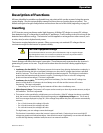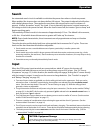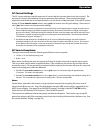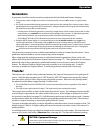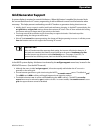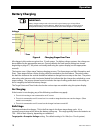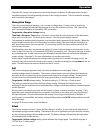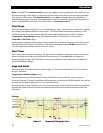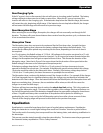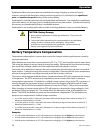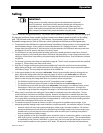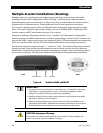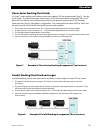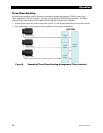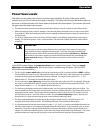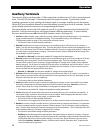
Operation
900-0114-01-00 Rev A 21
New Charging Cycle
If the AC source is lost or disconnected, the unit will return to inverting mode if enabled. The battery
voltage will begin to decrease due to loads or natural loss. When the AC source is restored, the
inverter will return to the charging cycle. If the batteries drop below the Rebulk voltage, the inverter
will restart the cycle, beginning at Bulk stage. If the batteries do not drop below Rebulk, the charger
will not enter the Bulk stage and will return to its previous stage.
New Absorption Stage
When entering the second stage, Absorption, the charger will not necessarily run through its full
duration. The timer will count down whatever time remains from the previous cycle, or whatever time
it has accumulated since then.
Absorption Timer
The Absorption timer does not reset to its maximum like the Float timer does. Instead, the timer
counts upward (gaining time) whenever the battery voltage drops below the Rebulk point. This
means that the Absorption period may not always be the same, depending on how much time it
has acquired.
In a 12-volt system, the Rebulk voltage is 12.2 Vdc. (All voltages in this section are given for a 12-volt
system.) This is a fixed setting and cannot be changed. For as long as the inverter remains below this
voltage, the Absorption timer will gain an equal amount of time. This dictates the duration of the
Absorption stage. Note that in Figure 5 the arrows show that the duration of time spent below the
Rebulk v
oltage is the same as the subsequent Absorption period.
If the battery voltage drops below 12.0 Vdc (in a 12-volt system), the timer increments (counts
upward) at double the normal rate. For example, if the batteries spent 8 minutes below this voltage,
16 minutes would be added to the Absorption timer. Similarly, if the battery voltage drops below
11.8 Vdc (in a 12-volt system), the timer increments at quadruple the normal rate.
The Absorption timer continues this behavior even if the charger is still on. For example, if the charger
is in Float stage and there is a significant battery drain, the charger may not be able to maintain the
batteries at the Float voltage. Once the batteries fall below the Rebulk point, the Absorption timer will
begin accumulating time. (However, the accumulation will be minor, as this will also cause the
charger to re-enter the Bulk stage.)
The timer will stop incrementing when it reaches the
absorb time limit
setting. This is the maximum
duration of the Absorption stage. This means that regardless of the voltage, the timer will always run
for the full Absorption period if the batteries dropped below the appropriate voltage for that amount
of time. If significant battery drain caused them to drop below the set points for doubling or
quadrupling the rate, it may run for the full Absorption period even after a lesser amount of time.
The rest of the charging stages will proceed as described on the previous few pages.
Equalization
Equalization is a controlled overcharge that is part of regular battery maintenance. Equalization
brings the batteries to a much higher voltage than usual and “simmers” them for a period of time.
This has the result of removing inert compounds from the battery plates, and reducing stratification in
the electrolyte.
This process must be started manually using the system display. The inverter cannot be programmed
for automatic battery equalization. This is a safety measure.



